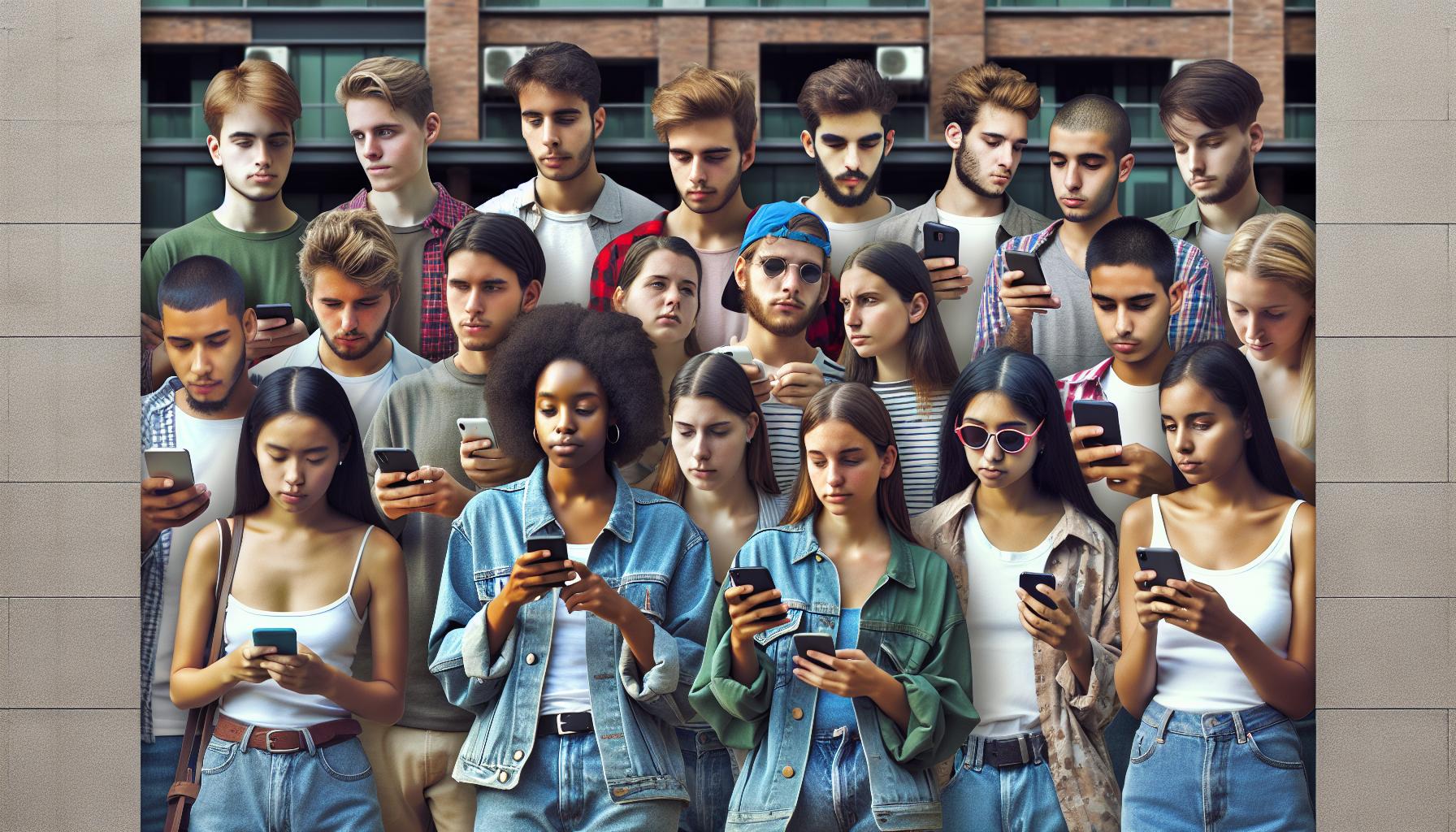In today’s digital landscape, social media platforms have become essential tools for communication, marketing, and connection. With billions of users worldwide, understanding social media use statistics is crucial for businesses, influencers, and individuals alike. These numbers reveal trends that shape how people interact online and influence marketing strategies.
As users flock to platforms like Facebook, Instagram, and TikTok, the dynamics of engagement continue to evolve. From age demographics to peak usage times, these statistics provide valuable insights into user behavior. By delving into the latest data, one can grasp the impact of social media on society and harness its power effectively.
Key Takeaways
- Global Reach: Over 4.9 billion people actively use social media, accounting for approximately 59.5% of the global population, highlighting its importance in communication and marketing.
- Platform Popularity: Facebook leads with 2.9 billion users, followed by Instagram with 2.0 billion and TikTok with 1.5 billion, each attracting unique user demographics and engagement styles.
- Mobile Dominance: A staggering 92.1% of users access social media via mobile devices, emphasizing the need for mobile-optimized content and marketing strategies.
- Engagement Trends: Users spend an average of 2.5 hours daily on social media, with visual content receiving significantly higher engagement than text-based posts.
- Demographic Insights: The age distribution shows that 32% of users are aged 18-24, highlighting the need for tailored marketing content that resonates with younger audiences.
- Influencer Impact: A significant 70% of teenagers trust influencers over traditional celebrities, making influencer partnerships crucial for brands targeting younger consumers.
Social Media Use Statistics
Social media use statistics provide critical insights into user behavior, platform popularity, and engagement levels. As of 2023, over 4.9 billion people use social media worldwide, representing approximately 59.5% of the global population. Platforms like Facebook, Instagram, and TikTok continue to dominate the landscape, each with distinct user characteristics and engagement patterns.
Key Statistics by Platform
- Facebook: Boasts over 2.9 billion monthly active users. This platform maintains extensive reach across diverse demographics, with notable engagement among users aged 25 to 34.
- Instagram: Engages 2.0 billion users, primarily among the younger demographic, particularly those aged 18 to 24. It features a focus on visual content, driving high interaction rates.
- TikTok: Surged to 1.5 billion monthly active users in 2023. This platform’s short-form videos attract a primarily Gen Z audience, influencing trends and culture.
User Engagement Insights
- Daily Use: Users spend an average of 2.5 hours daily on social media. This indicates a strong reliance on these platforms for entertainment and information.
- Content Preference: Visual content garners 94% more views than textual content. This emphasizes the effectiveness of images and videos in reaching audiences.
- Influencer Marketing: 70% of teenagers trust influencers more than traditional celebrities. Brands increasingly leverage influencer partnerships to enhance credibility and engage younger audiences.
Mobile vs. Desktop Usage
- Mobile Usage: 92.1% of social media users access platforms via mobile devices. This statistic underscores the need for mobile-optimized content and campaigns.
- Desktop Usage: Only 7.9% of users engage through desktops, indicating a significant shift toward mobile-first strategies.
- Age Distribution: 32% of users are aged 18 to 24, while 29% fall within the 25 to 34 age group. Understanding this distribution aids in tailoring content and marketing strategies effectively.
- Gender Breakdown: Women represent 50.9% of social media users, compared to 49.1% for men. This balance showcases the necessity for gender-inclusive marketing tactics.
Monitoring these social media use statistics is essential for businesses and marketers aiming to optimize their strategies and reach their target audiences effectively. Keeping abreast of these trends ensures relevance in a rapidly evolving digital landscape.
Key Platforms and Their Usage

Understanding the statistics of key social media platforms offers insights into their user bases and engagement levels. This data helps organizations tailor their marketing strategies.
Facebook Statistics
Facebook boasts over 2.9 billion monthly active users, making it the largest social media platform. Approximately 36% of users are aged 25 to 34. Engagement is significant, with users spending an average of 33 minutes daily. Video content sees higher interaction rates, with 8 billion video views daily. Facebook also reaches 1.29 billion users from mobile devices, emphasizing the platform’s mobile optimization.
Instagram Statistics
Instagram engages around 2.0 billion users, primarily within the 18 to 34 age range. Users spend an average of 30 minutes per day on the platform, with Stories contributing to over 500 million daily views. Visual content excels, as posts with images receive 650% more engagement than text-based content. Approximately 90% of users follow at least one business account, highlighting Instagram’s significance for brands.
Twitter Statistics
Twitter has approximately 450 million monthly active users, with 42% aged 18 to 29. Users engage for around 3.3 minutes per session, with tweets containing images seeing a 150% higher retweet rate. The platform supports real-time conversations, with over 500 million tweets sent daily. Twitter’s demographic is slightly more male, comprising about 68% of users, emphasizing its diverse audience.
Demographics of Social Media Users

Understanding the demographics of social media users reveals critical insights into user behavior and platform appeal. The following details outline the age groups and gender distribution among these users.
Age Groups
Social media platforms attract different age groups, influencing content creation and marketing strategies. The age distribution of social media users includes:
- 18 to 24 years: 32% of users fall within this age range, largely utilizing platforms like TikTok and Instagram.
- 25 to 34 years: This group comprises 24% of users, actively engaging on Facebook and Instagram.
- 35 to 44 years: Representing 18% of the user base, individuals in this range are more prevalent on Facebook.
- 45 to 54 years: This segment makes up 13% of users, primarily utilizing Facebook for connectivity.
- 55 years and older: 13% of users belong to this age group, showing increasing engagement on Facebook.
These age dynamics highlight the need for tailored content across platforms to accommodate varying preferences and interests.
Gender Distribution
Gender distribution demonstrates notable trends in social media usage. Current statistics indicate the following percentages:
- Female Users: Women account for 54% of social media users, showing a strong presence across platforms like Instagram and Pinterest.
- Male Users: Men make up 46% of users, exhibiting higher engagement levels on platforms like Twitter and gaming-related networks.
Recognizing these gender patterns aids marketers in creating campaigns that resonate with each demographic’s preferences and behaviors.
Trends in Social Media Usage

Social media usage continues to evolve, showcasing various engagement patterns and content behaviors across platforms. Understanding these trends offers valuable insights into how users interact with content daily.
Daily Engagement Levels
Daily engagement levels reveal significant insights into user interactions. Users spend an average of 2.5 hours on social media each day, with platform-specific variations. Facebook users dedicate approximately 33 minutes daily, engaging predominantly with video content. Instagram users exhibit higher interaction with visual storytelling tools, while TikTok users spend an average of 52 minutes daily, highlighting the platform’s appeal, especially among younger audiences. Engagement levels vary by demographic; for instance, users aged 18 to 24 display higher activity rates compared to older groups, reflecting the importance of tailored content strategies.
Content Sharing Habits
Content sharing habits influence user engagement and brand visibility. Over 70% of users on Facebook share content with their followers, while Instagram boasts a 90% engagement rate for posts that include user-generated content. Influencers drive sharing behaviors, with 80% of users indicating a likelihood to share posts from their favorite influencers. Users often prefer visual content, leading to a 65% increase in shares for posts featuring images and videos compared to text-only posts. Understanding these sharing habits allows marketers to create campaigns that encourage greater interaction and visibility across social media channels.
Impact of Social Media on Society
Social media profoundly influences various aspects of society, shaping communication, relationships, and cultural norms. It fosters instant connectivity, allowing individuals to share experiences and opinions worldwide. This global reach impacts social movements, with platforms serving as catalysts for activism and awareness.
Social media also alters communication styles. With 59% of users preferring visual content, platforms encourage brevity and creativity in messaging. This transformation affects how businesses convey information, emphasizing the importance of engaging visuals and concise text in marketing strategies.
Mental health issues linked to social media usage warrant attention. Studies indicate that 40% of users experience anxiety related to social media engagement. Online interactions can lead to feelings of inadequacy and comparison, particularly among younger demographics. Constant exposure to curated lifestyles exacerbates self-esteem concerns.
Social media’s role in shaping opinions cannot be ignored. Approximately 64% of users seek news from social platforms, signaling a shift in how information is consumed. This trend raises questions about the credibility of sources, as misinformation can spread rapidly. Engaging users requires marketers to verify and present accurate information to maintain trust.
Advertising on social media, especially through influencer partnerships, drives changes in consumer behavior. About 49% of users rely on influencer recommendations when making purchase decisions. This trend illustrates the power of relatable figures over traditional advertising methods, emphasizing authenticity in marketing approaches.
Social media also enhances convenience in various sectors, including e-commerce. Users can discover products, read reviews, and purchase items directly from platforms, improving the shopping experience. Nearly 54% of users report feeling more inclined to buy after discovering products on social media.
Social media significantly affects interpersonal relationships, mental health, information consumption, and consumer behavior. Understanding these impacts enables businesses and individuals to navigate the digital landscape effectively, aligning strategies with evolving social dynamics.
Shaping the Way People Engage With Content
Social media continues to shape the way people connect and engage with content. Understanding the latest statistics is crucial for anyone looking to navigate this dynamic landscape effectively. As platforms evolve and user preferences shift, staying informed on trends and behaviors can significantly impact marketing strategies and user engagement.
With billions of users spending considerable time online, the potential for businesses and influencers to reach their target audiences is immense. Adapting to these trends not only enhances visibility but also fosters deeper connections with users. Embracing the insights gained from social media statistics will empower brands to thrive in an increasingly digital world.